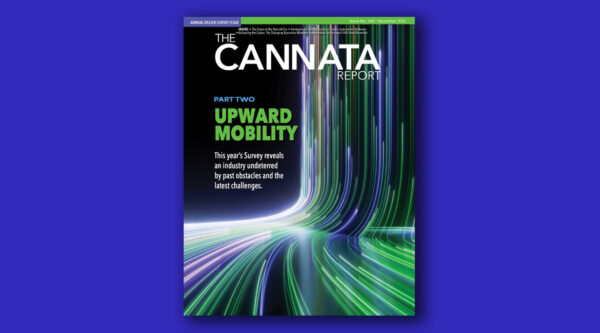Reflecting on Our First 40 Years and Looking Forward to What’s Next
This year marks the 40th anniversary of Marketing Research Consultants (MRC), the market research company, that would start publishing what would eventually become The Cannata Report five years later.
Launched on January 5, 1979, my initial intent for MRC was to help offshore manufacturers improve their performance in the independent dealer channel.
Even though I had only started working with Japanese manufacturers five years prior, both directly for a Japanese manufacturer, Canon USA, and a company that was privately labeling product, Konishiroku (Konica), I felt confident I could offer this value proposition. My experience with these two companies gave me invaluable insights into the Japanese culture with the opportunity meet and learn how the Japanese people think in terms of the obligations to their employers.
As the son of an Italian immigrant, the Japanese work ethic resonated strongly with me, making this venture a highly personal one. My father came to this country as a young man seeking his fortune. With a strong work ethic driving him, he built a successful business during the Depression, working six days a week, as well as many a Sunday morning.
I consider myself to be fortunate that my first two clients were Konica and Minolta. I will always be especially grateful to Sam Kusumoto, president and CEO, and founder of Minolta in the U.S.A., who gave me a chance and taught me a great deal.
One of my tasks was to attend the Hannover Fair in Hannover, Germany. In the 1980s, the Japanese philosophy was to introduce a new product in Japan during year one. In year two of the product, they would begin selling the product in Europe, and by year three, they would roll it out in the United States.
By attending the Hannover Fair, I could see what was coming to the U.S. in the next two to three years. And I was able to share this knowledge with readers, as well as the Japanese attitudes towards the U.S. market.
Three years seems like a long time to roll out products to the United States, but the Japanese companies had their reasons. The primary driver for such a long build-up to a release in the U.S. was the approach to servicing early copier products. Japanese manufacturers were not big on retrofits, and there was no such thing as a recall. If there was a part failure (unintended or designed to malfunction), the burden was on the dealer to replace it with the dealer absorbing the labor cost.
When a Japanese or European technician responded to a call from a copier customer, they’d bring out their kit, which included a mat that folded out to about 3′ x 4′. Then, the tech would take the machine apart to figure out the problem. If necessary, they would replace the part and reassemble the machine. I saw this done many times.
In the U.S., dealers wanted their technicians to change parts quickly and move on to their next call. As a result, they were more “parts changers” than technicians. Of course, there were exceptions and some of those techs would eventually become dealers. Our readers may be familiar with Herb Chambers of A Copy in Glastonbury, Connecticut. He was a technician for APECO in Boston and was occasionally asked to go out and help a dealer. He quickly learned how much money was to be made selling and servicing copiers and started his own business in Hartford, Connecticut, by borrowing $5,000 from his mom. He was just one of many who went that route.
This commitment to excellence fueled the entrepreneurial spirit that drove Herb Chambers and many other dealers we have come to know and respect in this industry. They believed in themselves and even if they didn’t consider themselves “businessmen,” they were convinced nobody was going to outwork them.
In 1982, while returning home from Germany’s Hannover Fair, I recall reviewing my notes from the event, outlining the areas my clients were most interested in hearing about. Though my two clients were my primary concern, I still had pages of notes about where the industry as a whole was going. That’s when it occurred to me that I should consider publishing a report that covered not only the Hannover Fair, but also NOMDA (National Office Machine Dealers Association) events as well. This was a time before manufacturers held their own dealer meetings, and this was the spark that started The Cannata Report.
Reflecting over four decades of being immersed in this industry, we have covered advances in technology such as when non-impact printers were first introduced to dealers followed by facsimile, word processing, mini computers, and color copiers, as well as the conversion of analog to digital, to dealers servicing the IT space, and so much more. What we have attempted to do, first and foremost, over the years is make dealers aware of new opportunities. We are proud to be among the first to tout printers, word processing, and other technologies to dealers.
But, it has always amazed me that whenever a new technology emerged, we’d hear dealers could never sell it. Yet, time and time again, dealers have proven they could. With a deep understanding of the committed work ethic and competency running strong in this industry, we have never wavered in our confidence in the people who make it happen each and every day.
Survey Says, Awards!
Of all the things we have accomplished over the years, we take great pride in our Annual Dealer Survey. In 1985, we wanted to have a better understanding of what dealers were doing and where they were having success. In our Survey, we asked dealers about their opinions of their manufacturers, which led to awards recognizing the manufacturers dealers identified as the leaders within our industry.
In 1986, we held our first Awards Breakfast at the NOMDA Show in New Orleans. When manufacturers started hosting their own dealer meetings, the writing was on the wall for our NOMDA Awards Breakfast. It was time to find a new venue and in doing so, change from a breakfast to a dinner event.
NOMDA evolved into BTA, and in 1996, we hosted our last awards dinner with that organization’s convention as the venue. In 1997, CDA (Copier Dealer Association) invited us to conduct our 12th Annual Awards event at the resort at The Greenbrier in White Sulpher Springs, West Virginia.
In 1998, we held our dinner at the Parker Meridian Hotel in New York City. In 1999, at the suggestion of Howard Geltzer, the owner of the public relations firm that represented Toshiba, we added a charitable component to the event, as we evolved from an awards dinner to an Awards & Charities Dinner. We took responsibility for all expenses, invited guests to bring a donation for the designated charity. Our first charity recipient was Child Help USA. We raised $37,500 that year but knew we could do much better.
At the turn of the century, the cost of New York City hotels had become cost prohibitive as a location for our Awards & Charities Dinner, so we decided to move our event to New Jersey, which has some of the greatest collections of catering facilities in the United States. Over the past ___ years, we have been able to raise, on average, $180,000 per dinner, all of which goes to charity. The money that guests pay to attend our dinner is a donation that goes directly to the designated charity.
At our most recent Awards & Charities Dinner, nearly 300 people gathered at The Madison Hotel in Morristown, New Jersey, to honor industry leaders. On a significant note, we presented our sixth Lifetime Achievement Award to Tom Johnson, industry trailblazer and the founder of Global Imaging Systems, now retired.
Since our first charitable event, we have raised more than $2.5 million for numerous charities and are looking forward to cracking the $3 million mark in the next two to three years.
If I’ve learned anything in coordinating these events, it’s that nobody does anything alone. Yes, it takes leadership, but our entire team has worked tirelessly together to build enthusiasm for these Awards dinners and charitable giving.
As I look back over my career thus far, I am grateful so this incredible ride and all the people with whom I’ve crossed paths. There is not space enough to thank them all.
Looking to the future, CJ is poised to elevate our organization ““ and our industry, I’m betting – to a whole new level, and I plan on enjoying this ride for as long as I am able. While I recognize there will come a time when that will no longer be possible, but it is satisfying to know I will have had the incredible experience of watching our son take the reins of the business that his mother and father built. We’re confident he will be creating not only a larger, better financed, and better equipped organization, but also one that addresses far more than the imaging industry.
Access Related Content
Visit the www.thecannatareport.com. To become a subscriber, visit www.thecannatareport.com/register or contact cjcannata@cannatareport.com directly. Bulk subscription rates are also available.


